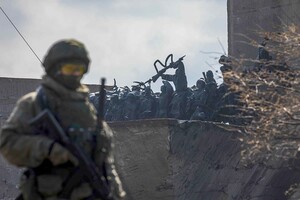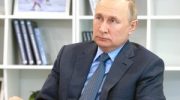Moscow has spent a lot of time and resources trying to transform its army from a Soviet to a modern one, but it has failed for a number of reasons.

Army cars were so old that repair crews stood virtually every 25 kilometers. And some officers launched themselves so much that they had to spend $ 1.5 to change their uniforms.
This was the Russian army more than 10 years ago when it invaded Georgia. The major and minor shortcomings were so obvious that the Kremlin announced its intention to begin a complete overhaul of the army to build a stronger, more flexible and professional force.
“But now, after three months of Russian invasion of Ukraine, it has become clear that the Kremlin has not been able to build an effective military machine. Russian forces in Ukraine have performed so poorly that they have surprised Western analysts, increasing the chances that Vladimir Putin's aggression will fail, “the New York Times reported.
By all accounts, despite the capture of territories in the south and east, the Russian army suffered a major defeat in Ukraine. She was forced to abandon plans for a lightning occupation of the entire country in a matter of days. Russian forces expelled from the outskirts of Kiev. The flagship of the Black Sea Fleet of the Russian Federation cruiser “Moscow” was destroyed. Control of the sky has not been established. And by some Western estimates, tens of thousands of Russian soldiers have died.
This war exposed the fact that the Russian army largely retains the military culture and behavior of the Soviet era. The command structure is not flexible, corruption in the army is extremely widespread. Meanwhile, Moscow is hiding its losses and repeating the mantra that everything is going according to plan. The symptoms of these problems were on the surface. Only last summer, Russia conducted military exercises, which, according to the Russian Defense Ministry, demonstrated the ability to coordinate the actions of 200,000 soldiers from different branches of the army. At the same time, an imitation of the fight against NATO troops was conducted. These were the largest military exercises in Russian history. Deputy Defense Minister General Yunus-Bek Yevkunov boasted to reporters that the Russian army had shown the ability to quickly deploy a combined force. And this ability “quickly sobers up any enemy.”
Read also: Focus: In the Seversky Donets, Russia's army has failed more than it seems
But the training took place under a strict scenario. No one played the role of rival. The main combat units spent months working out the choreography of their actions. And each maneuver began and ended at a strictly defined time. Analysts estimate that the actual number of troops participating in these exercises was about twice as small as in Moscow.
“In fact, this is the Soviet army. The reforms have made it more effective, but they have only come halfway, “said Kamil Galeyev, a Russian analyst and former researcher at the Wilson Center in Washington.
After the war against Georgia in 2008, Russia tried to reformat its armed forces. The idea was to abandon the centralized Soviet army, which was supposedly able to mobilize up to 4 million soldiers in a short time. Instead, field officers needed more power. Units needed to be taught to synchronize their skills. And the whole Russian arsenal had to go into the computer age. Many traditionalists resisted change, following the old model of gigantic, concentrated force. But other factors have also contributed to the Russian army's inability to transform. The birth rate collapsed in the 1990s, leading to a reduction in the number of men who could be called up for military service. This, as well as extremely low salaries, led to the failure of the recruitment goals. Endemic corruption ruined all efforts.
But the main problem was that the military culture of the USSR was preserved, despite the lack of men and means to support it.
“The Soviet army was built to accumulate millions of soldiers to fill an extremely large number of divisions with endless reserves of equipment. It was created for World War III, for the war with NATO, which never started, “said Michael Coffman, director of Russian research at CNA.
So, in fact, the momentum of change quickly faded, leaving behind a hybrid version of the army that did not live up to the more flexible modern force, but was no longer the old version based on conscription. It still relies more on artillery than on infantry, which can capture and hold territory. The military exercises, which took place under a strict scenario last summer, were eloquent./p>
Instead, officers were judged on their ability to follow instructions clearly. Russia wanted the world to see its army as it seemed during Victory Day parades. That it is supposedly a well-established military instrument of slender soldiers in beautiful uniforms marching in unison with formidable weapons in hand.
Read also: WSJ: In preparing for war against Ukraine, the Russian army mistakenly believed in the calculations of the 19th century < "Moscow is using the Armed Forces as a propaganda machine," said Russian Air Force Lieutenant Gleb Irisov, who resigned in 2020 after five years of service.Russia's senior military command says the involvement of Russian forces in foreign military operations, especially in Syria, has provided real combat experience. But analysts question that assertion. Because in Syria, Russian troops did not resist a real rival. They conducted their operations mainly by the Air Force. The pilots flew over their targets calmly and as much as they wanted. Russia has not fought major land battles since World War II. However, the Russian government exaggerated its military successes. During a meeting with representatives of the Philippine government, Defense Minister Sergei Shoigu boasted that the Russian army had "liberated" 503,000 square kilometers of Syrian territory. The problem is that the figure he named is twice the real area of Syria.
With 900,000 personnel, a third of whom are infantry, the Russian Armed Forces are not as large as the army, which has to defend vast territories that stretch through 11 time zones. Ten years ago, Moscow set a goal of recruiting 50,000 soldiers for contract service. However, this goal constantly failed. Therefore, there is still a mandatory conscription in the country for all men aged 18 to 27. Putin has not yet announced a mass mobilization that will force all adult men to go to war.
Read also: The Economist: How rotten is the Russian army?
However, if he did , infrastructure would be needed for mass training of civilians. And such an infrastructure does not exist in Russia. As a result, those Russian troops that are already fighting in Ukraine are virtually all Russian ground forces. And because of corruption, the Russian army lacks resources and weapons. Budgets are being stolen en masse. And because of this, the army still cannot afford advanced weapons, such as T-14 Armata tanks and fifth-generation aircraft.
Swedish Defense Research analyst Johann Norberg says the Russian army will not be able to solve each of your problems even in 10 years. The war in Ukraine has exposed the fact that the Russian army, “not only is not three meters tall, it does not pull even a meter,” said the Swedish expert.




